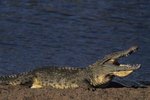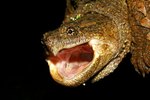
American crocodiles (Crocodylus acutus) and American alligators (Alligator mississippiensis) are closely related reptiles that are sometimes difficult to tell apart without knowing a few distinguishing characteristics. Their life cycles are very similar to one another's, although each species has its own specific behaviors, including mating rituals and maternal care.
Mating and Courtship
The two species display courtship rituals that are somewhat similar. In both species, the males perform various displays to garner the affections of a willing female. Beginning in April, male alligators will roar or bellow at the surface of the water, creating deep vibrations that ripple the water. They may also rub, blow bubbles or vocalize. Male crocodiles, on the other hand, start courtship in January or February by slapping their heads quickly and repeatedly until a female accepts his advances and raises her tail and snout in an invitational manner. The male follows by vibrating his body in the water.
Nests and Hatchlings
Female alligators build their vegetation nests after mating. Nests are large, averaging 7 to 10 feet in diameter and up to 3 feet high. She lays anywhere from a few dozen to 90 eggs in early summer and carefully covers them in the nest. Female crocodiles build their nests prior to mating; nests are either holes in or mounds of soil that are always elevated well above the water mark to prevent the nests from flooding. Crocodiles lay approximately 30 to 60 eggs.
Incubation and Hatching
Eggs of both species take approximately 9 or 10 weeks to complete incubation. The sex of the eggs is determined by the temperature of the nest. The babies begin making high-pitched noises right before hatching, which alerts the mother to the nest to remove the excess vegetation she placed on top to hide and incubate the eggs. While this process is similar for both species, maternal care is slightly different. Both species will escort their brood to the water, but crocodiles then leave their babies to fend for themselves. Mother alligators, on the other hand, protect their young for a year until the mothers begin preparing for the next year's brood.
Early Life and Maturity
Due to their small size, young alligators and crocodiles have high mortality rates -- 80 percent of young alligators become prey to birds, raccoons, crabs, bobcats, snakes and larger alligators. Growth depends greatly on the surrounding environment, including temperature, and sexual maturity is reached at approximately 6 feet long. The life span varies greatly for these large reptiles, averaging 35 to 50 years for wild alligators and 60 to 70 years for crocodiles.
References
Photo Credits
-
Jupiterimages/Photos.com/Getty Images
Writer Bio
With a professional background in gardening, landscapes, pests and natural ecosystems, Jasey Kelly has been sharing her knowledge through writing since 2009 and has served as an expert writer in these fields. Kelly's background also includes childcare, and animal rescue and care.




